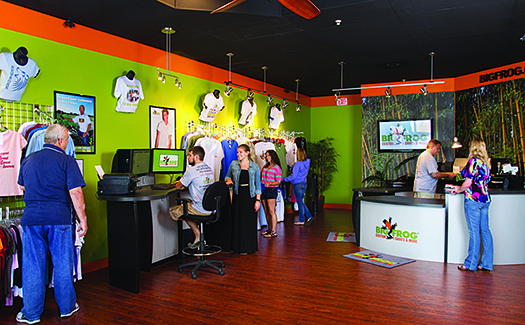A Tale of Two Screen Printers
Communication and community engagement have been crucial to the success of the apparel screen-printing and embroidery company VilleSide Customs.
FULL STORY
When Michael Rothermund got laid off from his fourth job in the engineering industry, he knew it was time for a change — and all signs pointed to the T-shirt business.
Having graduated college in 2001 with a computer science degree, he began his career as a software engineer and later worked as a firmware engineer, but his experience with an outplacement agency in October 2010 led to an unexpected career move.
“I took a couple classes and I met a guy from FranNet, who sold franchises,” Rothermund says. “I did validation and research on all the different companies and ultimately just thought doing T-shirts would be pretty cool, so I decided to take the leap and try something different for once.”
A Fresh Start
Rothermund traveled to Florida to pursue a franchise opportunity with Big Frog Custom T-Shirts & More, a custom-printed apparel company specializing in full-color designs. He met with the company’s executive team — CEO Leeward Bean, Vice President and COO Ron DeFrece and Executive Vice President Tina Bacon-DeFrece.
“They were instantly my friends and exactly my kind of people because they are all from scientific backgrounds themselves,” Rothermund says.
In 2011, he purchased his first store from Big Frog — which currently has about 70 stores across the country — in Greensburg, Pa. And when a store located near his family in Charleston, S.C., became available, he purchased it as a second location, then closed and relocated it to Cranberry, Pa., in February 2015 to simplify day-to-day operations.
Putting his engineering background to use, Rothermund has become not just a business owner, but a mover and shaker for Big Frog.
Wearing Many Hats
“Right after my store opened, Big Frog offered the possibility of a vinyl cutter,” Rothermund says. “So, I jumped on board right away and I was one of the first people to test out the vinyl cutter, but then all we were doing was pressing it on shirts.”
While the T-shirt had always been his top-selling product, he noticed increasing demand from customers for hats.
At the time, Big Frog stores were using Geo Knight modular heat presses, so Rothermund investigated the possibility of adding a hat accessory to the machine.
He did market research, tested certain products and talked to customers — ultimately realizing that most customers wanted small hats instead of larger trucker styles.
“I ended up going to a machine shop to have the hat press we had purchased modified so that we could print on smaller hats,” he says. “After that, we contacted Geo Knight as a franchise and told them we needed a smaller size and they were able to accommodate us.”
Beyond figuring out the actual hat platen size, he determined the amount of time Big Frog owners should press a hat and how to attach it to the platen so it wouldn’t melt — all of which inspired company-wide documentation and video instruction for other franchisees. The unique procedure also earned Rothermund the company’s Innovator of the Year Award in 2012, an impressive feat considering he had only entered the T-shirt business the prior year.
Re-engineering the Business
His determination to bring innovation to the company didn’t stop there. Serving the Pittsburgh area, Rothermund needed a way to print on black T-shirts, with so many customers requesting black- and-gold garments to support local professional sports teams. He had been getting by with his standard CMYK direct-to-garment printer, but he discovered a new Siser solvent-based vinyl and set out to inspire change — once again.
Pitching the new solvent-based vinyl, combined with a new Mutoh 24-inch printer, he got permission from Big Frog to test a new process. After three-and-a-half months of testing and tweaking, he developed a successful system and presented it at the company’s annual conference in January.
Rothermund says his detail-oriented nature, community involvement and background have helped him find success in what he says can be a cutthroat industry. “Being an engineer has a lot of advantages for a business like this,” he says. “There’s a lot of equipment and a lot of technical things, so knowing how everything works definitely helps a lot.”
Communication and community engagement have been crucial to the success of the apparel screen-printing and embroidery company VilleSide Customs.
FULL STORYStrap yourselves in because we are back on the road to complete our live-decorating adventure! This time visiting Equipment Zone and STAHLS’.
FULL STORYBuckle up ‘cause we are on a mission! In the ever-evolving world of technology, there are so many ways to tap into your creative outlet and turn it into a lucrative business in the decorated-apparel industry.
FULL STORY